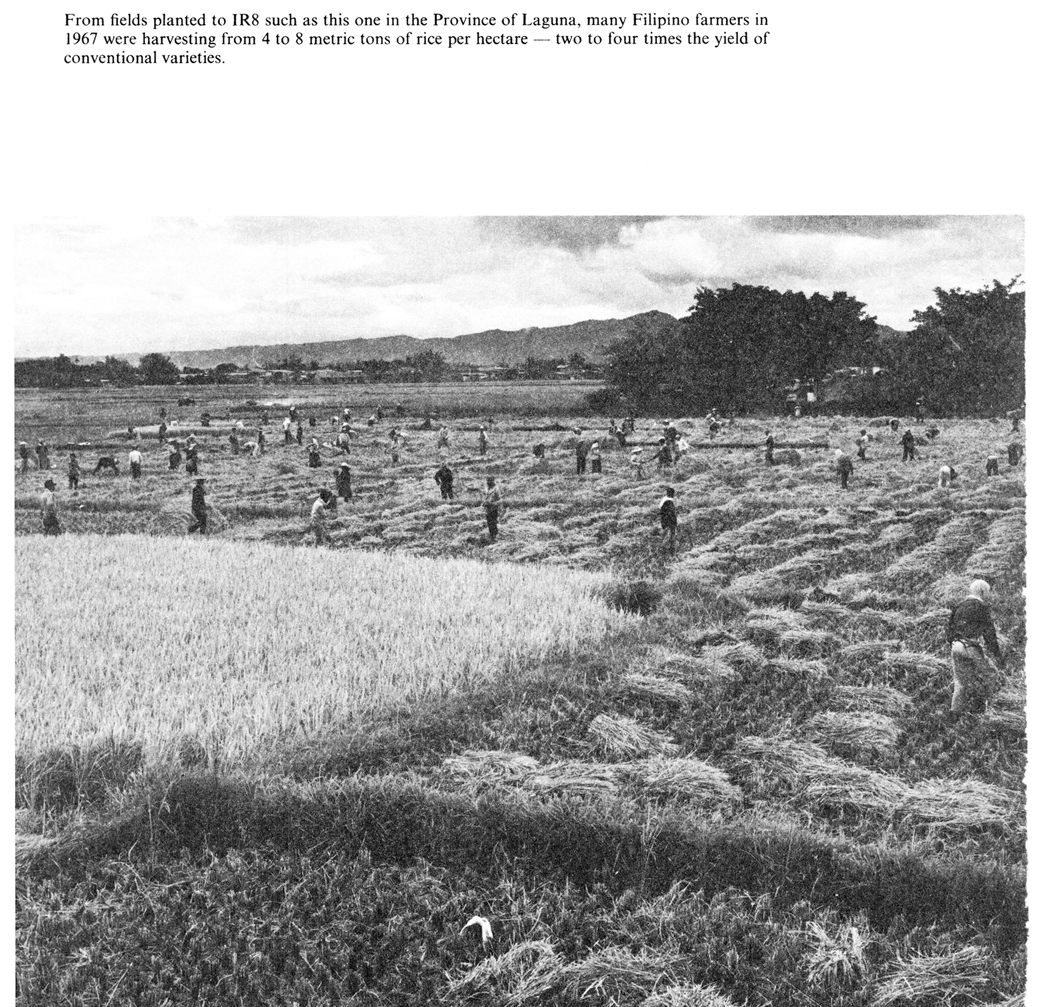The great contribution of IR8 is its high yield potential, which, of course, derives from its short stature, its vigorous tillering ability, and its nitrogen responsiveness. These characteristics constitute a revolutionary new plant type, of which IR8 was the initial variety. The plant type is here to stay; varieties, however, will come and go, and IR8 soon will be out of date. New varieties are being developed that will retain the shortness, the yielding ability and the fertilizer responsiveness of IR8 but will possess greater disease resistance, improved grain quality, and desirable variations in crop duration to suit the different requirements of the various Asian countries.
.
Director’s Introduction
 Undoubtedly, the most significant accomplishment of the Institute during 1967 was the widespread adoption of IR8 by farmers, not only in the Philippines and in other countries of South and Southeast Asia, but in many other rice-growing nations around the world. Although a specific project for farmer acceptance of a variety is not a direct activity of the Institute, it is nevertheless a distinct outgrowth of the Institute’s program. As indicated in the 1966 Annual Report, the Institute produced an abundance of seed, prepared and distributed appropriate instructions for the culture and management of the new variety, and trained many extension workers in the techniques of modern rice production.
Undoubtedly, the most significant accomplishment of the Institute during 1967 was the widespread adoption of IR8 by farmers, not only in the Philippines and in other countries of South and Southeast Asia, but in many other rice-growing nations around the world. Although a specific project for farmer acceptance of a variety is not a direct activity of the Institute, it is nevertheless a distinct outgrowth of the Institute’s program. As indicated in the 1966 Annual Report, the Institute produced an abundance of seed, prepared and distributed appropriate instructions for the culture and management of the new variety, and trained many extension workers in the techniques of modern rice production.
The most phenomenal change has occurred in the Philippines. In the province of Laguna, by December, 1967 over 52 percent of the rice farmers were growing IR8. Only 18 months earlier, Laguna farmers growing the variety could have been numbered on the fingers of one hand.
Admittedly, the province of Laguna is not typical of the Philippines in general. It has excellent soils for lowland rice culture; over much of its area year-round irrigation can be and is practiced; and in it are situated both the College of Agriculture (of the University of the Philippines) and The Inter-national Rice Research Institute. However, some 10 other provinces are moving fast in the adoption of the newest varieties and of the appropriate cultural practices that, together, allow farmers to double and even triple their previous grain yields. It is estimated that more than 200,000 hectares of IR8 were grown in the Philippines during the main (rain-fed or monsoon) crop season of 1967 and that, conservatively, the resulting additional net profit to Filipino farmers was P58,200,000 (US$15,000,000). Furthermore, the economy of the country obviously has been helped considerably through increased sales of fertilizer and of the products of other industries serving agriculture.
India got off to a late start in the multiplication and distribution of the IR8 variety. However, over 150,000 hectares were grown in 1967, and some estimate that at least one million hectares will be grown in the monsoon season of 1968. The Institute was partly responsible for the introduction into India of Taichung (Native) 1, which, in spite of its defects, has markedly increased rice yields on more than a million hectares of rice land.
In Pakistan, with the help of the Ford Foundation, significant progress is being made. The fastest spread is occurring in West Pakistan, where abundant sunshine and low disease incidence are conducive to high yields. Moreover, the farmers, accustomed by now to short wheats, seem to be accepting short rice avidly. Predictions are that about 500,000 hectares of rice area in West Pakistan will be planted to IRS in 1968.
In East Pakistan, on the other hand, IR8 is beset, in the monsoon season, by problems of disease and deep water; and at that time of year IR8 seems to be doing better. In the dry season, however, IR8 is popular with the farmers. Even so, because of the unique wet-season difficulties, coupled with the greater conservatism of the East Pakistani farmer with respect to dwarf crops, the acceptance of IR8 is not yet up to early expectations. The year 1968 should give a clearer picture of the spread of this variety in East Pakistan.
A word might be in order, here, about the Institute’s view of the position and role of IR8. The great contribution of IR8 is its high yield potential, which, of course, derives from its short stature, its vigorous tillering ability and its nitrogen responsiveness. These characteristics constitute a revolutionary new plant type, of which IR8 was the initial variety. The plant type is here to stay; varieties, however, will come and go, and IR8 soon will be out of date. New varieties are being developed that will retain the shortness, the yielding ability and the fertilizer responsiveness of IR8 but will possess greater disease resistance, improved grain quality, and desirable variations in crop duration to suit the different requirements of the various Asian countries.
In the meantime, the spread of IR8, in Malaysia, Ceylon, and even Mexico (where it is highly acceptable) continues and could be cited in detail. Perhaps, however, it is sufficient to state that the variety is being grown in more than 60 countries throughout the world, is being intensively multiplied in the principal tropical countries of South Asia, and is now gaining rapid acceptance in several countries of Latin America.
In late 1967, the Institute named its second rice variety when the genetic line first known as IR5-47-2 was designated as IR5. The newer variety is slightly taller than IR8 but has greater resistance to the bacterial blight and tungro virus diseases. The initial pure seed of this variety is being produced at the Institute and, along with that of IR8, no doubt will continue to be multiplied extensively until the anticipated better varieties appear during the next few years.
 The Agronomy Department continued its program along lines similar to those reported last year. It intensified its studies of direct seeding methods. As a result, the highest yield ever obtained at the Institute-10,341 kg/ha—occurred in a direct-seeded field of IR8.
The Agronomy Department continued its program along lines similar to those reported last year. It intensified its studies of direct seeding methods. As a result, the highest yield ever obtained at the Institute-10,341 kg/ha—occurred in a direct-seeded field of IR8.
A group of the newest varieties was tested under upland conditions and compared with several standard recommended Seedboard upland varieties of the Philippines. The truly phenomenal yield (for an upland crop in the monsoon season) of 6,191 kg/ha was obtained with IR5. This was about 50 percent higher than the yield obtained with Palawan, one of the recommended Seedboard varieties. Actually, the yield of IR5 in this experiment topped, by about two metric tons, any previous yield of rice under upland culture obtained on IRRI’s experimental plots during the past 5 years. Naturally, such a yield could not have been obtained without an excellent distribution of rainfall during the growing season. The variety IR8 produced the next highest yield, with a recorded 5,678 kg/ha.
The chemical weed control work of the Agronomy Department was continued, and further studies of “Daxtron”, or “Pyriclor” (its new name), point out that compound’s potentiality as a good selective herbicide of low cost. Unfortunately, the company producing this herbicide has not been able to place it on the market because of manufacturing difficulties. Several promising new chemicals appeared during 1967, and the results of their experimental use are presented later in this report. It is predicted that within the next few years chemical weed control for flooded rice will be so much perfected that farmers who wish to do so may eliminate hand weeding completely.
The Plant Pathology Department continued to screen varieties and genetic lines for resistance to the principal diseases. In cooperation with the Varietal Improvement Department, it discovered several lines that have high resistance to bacterial blight and to the tungro and grassy stunt virus diseases, and a broad spectrum of resistance to the many races of rice blast disease. The superior yields obtained by IR5 over IR8 in many instances during the monsoon season demonstrated the importance of disease resistance. Certain of the crosses with TKM-6 from India are producing some dwarf lines that have resistance to the several virus diseases, to bacterial blight, and even to rice stem borers.
During the next two or three years, the Institute undoubtedly will release several new varieties that will combine this high disease resistance not only with good plant type, but with improved grain shape, size and eating and cooking qualities. In fact, the work has progressed to the point where several promising lines, selected from single-row plantings, were planted for the first time in December, 1967, in multiple-row yield trials.
Although the Entomology Department continues to find diazinon the best chemical for the control of stem borers and leafhoppers, it is still seeking a systemic insecticide that will give better control of the brown planthopper, which is the vector of the grassy stunt virus disease and which causes serious direct injury as well.
As mentioned earlier, the entomologists, by crossing TKM-6 from India with IR8 and other similar new dwarf varieties, have developed dwarf rice varieties that have considerable resistance to the rice stem borers. Probably, a variety with complete immunity to these insects never will be developed; but, as pointed out in the 1966 Annual Report, chemical control is greatly facilitated by having a degree of resistance in a variety. For example, when Rexoro, a highly susceptible variety, is grown in large fields, it is impossible to obtain effective control of the stem borers with diazinon; but when IR8, a moderately susceptible variety, is grown, diazinon provides good insect control.
The Chemistry Department has found over 100 varieties of rice from the world collection that have a grain protein content of more than 13.5 percent in several successive plantings (the average value for rice is about 8 percent). Because these hundred-odd varieties came from a collection of 8,500, the high protein content, of course, could be simply a matter of chance. Work on the selected varieties is continuing in order to ascertain whether there are among them any that possess a genetic character for high protein. Furthermore, these initial, high-protein varieties are being studied to determine the distribution of the essential amino acids, in the hope of finding some varieties that consistently have a lysine content in the protein of over 4 percent. The Agricultural Engineering Department during 1967 designed, constructed and tested a new type of mechanical thresher which, with its promise of low investment and operation costs, should be of decided value in South and Southeast Asia, where farm incomes are low. Threshing in those regions is now done largely by hand or by animal treading.
The Agricultural Economics Department has produced considerable data to support the contention that the new varieties, such as IR8, under low levels of management perform as well as the traditional tall, tropical varieties, and at high management levels do much better. Under top management, the profits from IR8 are about twice those obtained from the traditional tall varieties.
Useful data are now being collected from Philippine farmers who have started to grow IR8. These studies will be completed in 1968 and should provide valuable information on factors influencing the accep[tance of technological innovations in agriculture.
Read the full IRRI Annual Report 1967








